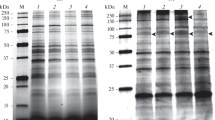Summary
A dye exclusion test for differentiating between live and dead tissue culture cells ofAedes aegypti is described. Erythrosin B at a final concentration of 20 mg/100 ml cell suspension stained these cells differentially; dead cells were stained red but the live ones did not take up the dye. There was a close correlation between the number of unstained cells and incorporation of14C-leucine. No significant increase was observed in the number of stained cells over a 1-hr staining period. Keeping the cells at 5°C up to 24 hr prior to addition of the dye affected neither total cell number nor the proportion of stained cells.
Similar content being viewed by others
References
Phillips, H. J., and J. E. Terryberry. 1957. Counting actively metabolizing tissue cultured cells. Exp. Cell. Res. 13: 341–347.
Hanks, J. H., and R. E. Wallace. 1958. Determination of cell viability. Proc. Soc. Exp. Biol. Med. 98: 188–192.
Kaltenbach, J. P., M. H. Kaltenbach, and W. B. Lyons. 1958. Nigrosin as a dye for differentiating live and dead ascites cells. Exp. Cell Res. 15: 112–117.
De Luca, C. 1965. The use of trypsin for the determination of cellular viability. Exp. Cell Res. 40: 186–188.
Paul, J., 1965.Cell and Tissue Culture. 3rd ed. E. & S. Livingstone, Ltd., Edinburgh.
Harris, M. 1966. Criteria of viability in heat-treated cells. Exp. Cell Res. 44: 658–661.
Grace, T. D. C. 1966. Establishment of a line of mosquito (Aedes aegypti L.) cells grownin vitro Nature (Lond.) 211: 366–367.
Grace, T. D. C. 1962. Establishment of four strains of cells from insect tissues grown in vitro. Nature (Lond.) 195: 788–789.
Sohi, S. S. 1969. Adaptation of anAedes aegypti cell line to hemolymph-free medium. Can. J. Microbiol. 15: 1197–1200.
Parker, R. C. 1961.Methods of Tissue Culture. 3rd ed. Paul B. Hoeber, Inc. New York.
Hayashi, Y., and S. S. Sohi, 1970. Metabolism ofAedes aegypti cells grown in vitro. 1. Incorporation of3H-uridine and14C-leucine. In Vitro 6: 148–152.
Author information
Authors and Affiliations
Additional information
Contribution 202, based on a paper read at the 21st Annual Meeting of the Tissue Culture Association held at Washington, D. C., June 15–18, 1970.
Rights and permissions
About this article
Cite this article
Sohi, S.S., Hayashi, Y. Metabolism ofAedes aegypti cells grown in vitro. II. Determination of cell viability. In Vitro 7, 146–151 (1971). https://doi.org/10.1007/BF02617958
Issue Date:
DOI: https://doi.org/10.1007/BF02617958




